At a busy intersection just outside the historic center of Wroclaw, stands an unusual collection of sculptures. These are statues of ordinary people going about
their daily business. But something isn’t right. On one corner the people are sinking into the pavement, and across the street, another group is rising out of the sidewalk. This art can be enjoyed at face value, but to truly appreciate the artist’s poignant message, it takes a glimpse at Poland’s recent turbulent history.
This artwork is called Przejście, which translates as passage or transition, and it’s also known in English as The Anonymous Pedestrians. These 14 figures were crafted by Polish artist Jerry Kalina in December 2005. In addition to being a fascinating piece of public art, it’s significant to Wroclaw because it marks the 24th anniversary of the imposition of martial law in Poland. This was a frightening time when the military arrested ordinary civilians in the middle of the night, many of whom were never seen again. The descending pedestrians are the missing.
After 2 years of military oppression, martial law was lifted, and ordinary citizens rose out of the earth on the other side of the street.
When martial law was instigated, the pro-democracy movement was gaining strength throughout Poland, and the communist government hoped the move would help rein in opposition groups like Solidarity. Anti-government organizations were banned, leaders were arrested, and thousands of soldiers patrolled the streets. A curfew was imposed, borders were sealed, phone lines disconnected, and airports were closed.
Martial law is an extreme measure, and it hasn’t been imposed in the United States since the Civil War. But when we lived in Sudan in the mid 80s, Terri and I had a firsthand look at what life under martial law is like.
Immediately after a military coup removed long-term dictator Jaafar Nimeiry, the army moved swiftly to take control of the city. All borders were closed, tanks were parked on the airport runway, curfews were put into place, the phone system was shut down, and roadblocks were set up throughout the city.
In the capital Khartoum, the restrictions only lasted a couple of weeks, and we worked hard to stay off the radar. Luckily, I only had one scary encounter at a military checkpoint where I experienced my first, and hopefully last, machine gun barrel thrust into my open car window. At the other end of the gun was an agitated soldier asking what I was up to.
We were on pins and needles constantly, and I can’t imagine what Poland must have gone through for 2 years.
Today, the democratic Poland is a very different place than in the 80s. But it’s certain that this sculpture is still a painful reminder for many Polish people. And after reading the artist’s inspiration for the The Anonymous Pedestrians, it was even more emotive for us. It reminded us of a troubled time in our past, and gave us an even greater appreciation for our peaceful lives.
Happy Trails,
James & Terri
Last updated September 2, 2023
Photo Credits: 7. Onyshchenko via Wikimedia Commons
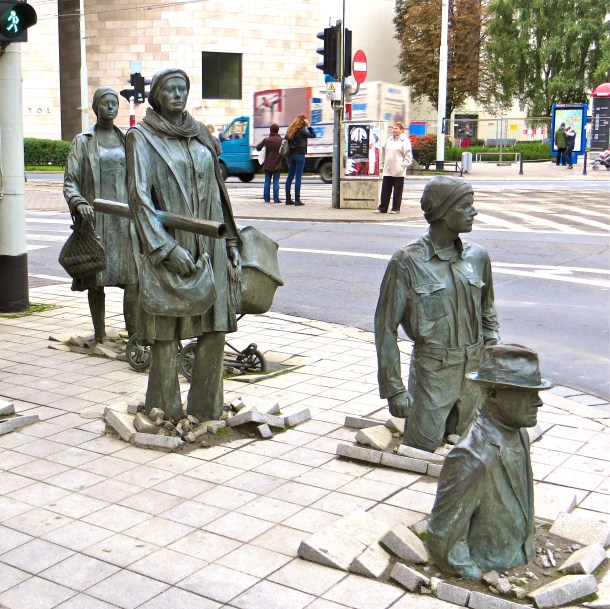
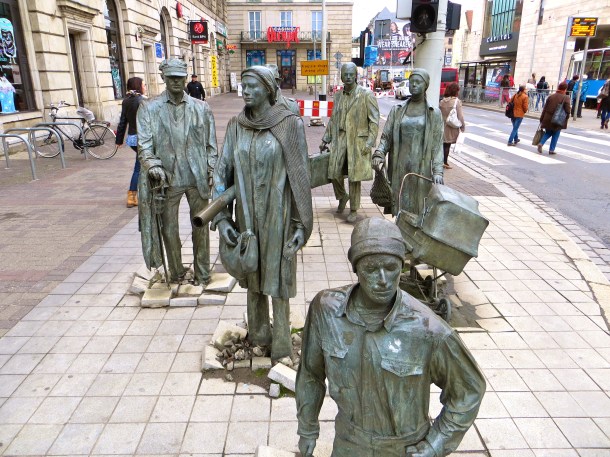


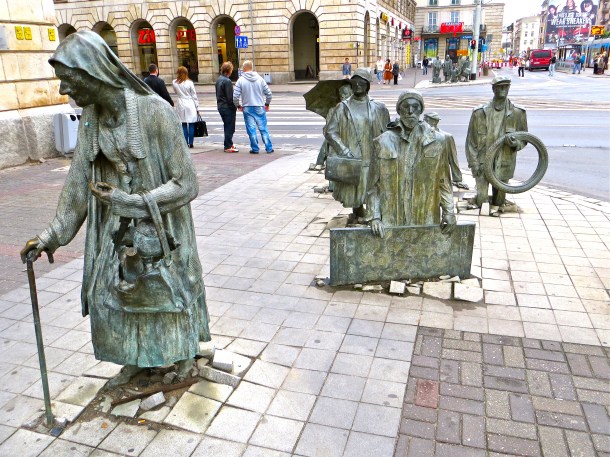
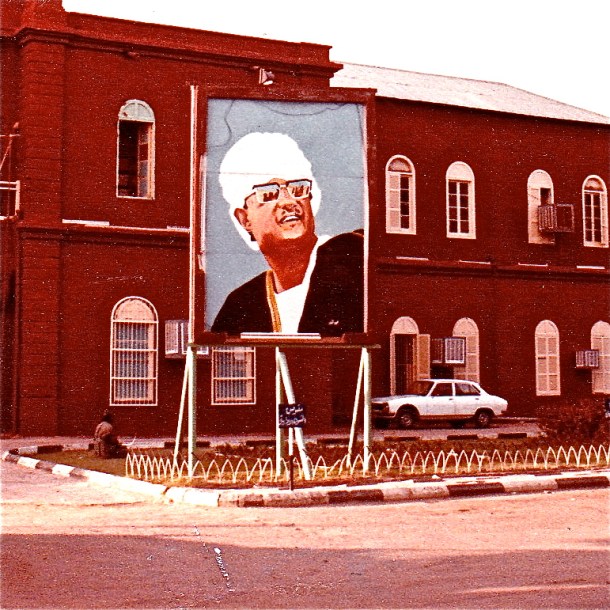
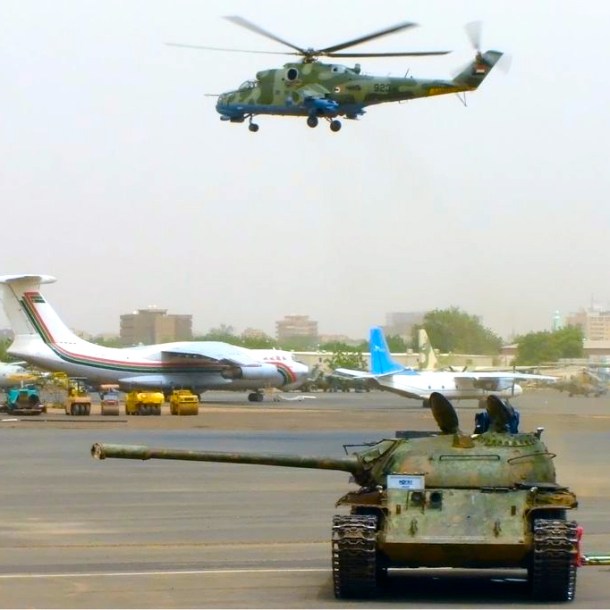

Fascinated by these sculptures both for the content as well as what they represent historically. But I’m really puzzled by the fact that I’ve never seen them. I would have thought they would have appeared in a magazine or newspaper account. So interesting.
Rusha, Wroclaw is such a vibrant, upbeat city that it’s easy to forget the difficult times that it and the rest of Poland have gone through. Obviously, this artist didn’t want us to forget, and that’s a good thing. ~James
James such a fabulous historical piece and a reminder how very fortunate we are to have such freedom. Should I ever find myself on this street corner I would be awestruck. Such poignant artwork.
Thanks Sue. North Americans have been incredibly lucky no doubt. Our time in Sudan was a real wake up call for us, and it changed us forever. Losing one’s freedom, even for a short time, is frightening to say the least. Public art like this work is a good reminder. ~James
solo la grande arte riesce a fermare e renderci consapevole di un momento così tragico nella vita di una nazione, è stato molto interessante osservare e leggere, sperando che sempre la civiltà avanzando porti a tutte le nazioni la ricchezza più grande : LA PACE
grazie per questo bellissimo post
Only the great art can stop and make us aware of this moment so tragic in the life of a nation, and it was very interesting to see and read, Hoping That advancing Civilization Ssmpre ports of all Nations, the greatest Wealth: peace
Thanks for THIS wonderful post
sorry I forgot to translate:-)
Poland’s past is filled with violence, oppression, and hardship. And as the saying goes, those that don’t know the past are destined to repeat it. This art will always stand as a reminder of the hardships that previous generations experienced. ~James
Unfortunately, in real life very often people who went missing never appeared again.
My wife’s father was arrested and executed when she was two months old. When she was 27 years old she received a letter from the government that her father was innocent.
We must always remember that giving any government too much power is dangerous for every citizen.
Thanks very much for this poignant comment JF. In privileged societies like ours it’s difficult for present generations to appreciate how lucky they are to have real freedom. Having a loved one suddenly disappear must be crushing, and knowing that the government is responsible must instill a debilitating helplessness. For us, travel helps us understand how important our freedom really is, and works of art such as this are an effective reminder. ~James
Good post – I enjoyed it!
Thanks Andrew. One of our motivations for traveling in Eastern Europe was to get a feel for what life must have been like in the communist era. Art and stories like this help us begin to understand. ~James
Last weekend we were in Wroclaw and went to see theses statues for ourselves. For me it was one of the highlights of the trip. Interestingly it doesn’t seem to feature in the guidebooks so I am thankful to you for this post which made me seek it out.
This is one of the reasons Mike and I travel. There are so many stories like this that one has to experience for themselves. We learned so much just two weeks ago on our trip to Bosnia-Herzegovina about what life was like during the war for everyone. Sadly, as in your story, these sculptures, while beautiful to us, are just reminders for those who lived it of the ugly past. How can the survivors heal when they have such reminders facing them on a daily basis? Perhaps the sculptures are there so no one ever forgets the ugliness, such as the monument being built in NYC for Sept. 11th. Every country seems to have in its history some sort of event such as this. Perhaps it is in traveling and in sharing these stories that we can help the survivors to heal; by giving them a voice to be heard. Thanks for sharing.
Florence I think that the points you raise are what differentiates tourists from travelers. As a tourist, it’s easy to breeze through, see the sights, eat the food, and move on. But travelers strive to learn the history, both good and bad, and try to understand the people, culture, and what made the place what it is. As 6-monthers, you and Mike fit squarely in the traveler category. The Anonymous Pedestrians is an interesting work of art that’s an effective reminder of a brutal past. But for me, there is no more sobering reminder of war and brutality than the bombed-out, bullet-scared buildings we saw in Bosnia. The reality of it is horrifying. I’m sure that you and Mike saw lots of these buildings as well. As a survivor, I think that I’d find these scenes even harder to take. Travel isn’t all fun, but it’s certainly all educational. ~James
A great and interesting post and I just love the sculpture street art. Very effective, thank you. MM 🍀
Thanks Mick. It’s an unusual piece, and the message makes the work even better. ~James
I think the message and how it is done is brilliant, once more thanks for sharing. 🍀
These are wonderful pieces of art as well as being highly evocative, James. I wasn’t aware of them so many thanks for the introduction. Seems in this world of ours there are always troubled times somewhere, and Poland’s certainly witnessed its share. A beautiful reminder! Many thanks 🙂
Thanks Jo. Sorry you missed them on your last trip. They’re a bit off the beaten path and take some searching. On your next trip to see your Polish relatives, you should look for them. Your family there may have some personal stories about the time. ~James
That is a really cool piece of public art!
Thanks Stephanie, I agree. As I said, the art can be appreciated at face value, but knowing the backstory makes it even more interesting. ~James
Thanks for sharing both the art and the story behind the art – very interesting and very humbling. One of the best things about travel for us is researching the history and the stories behind each area. Knowing the history of a place and the events that shape a country gives us an appreciation of the places we visit and the people we meet as well as reminding us how truly fortunate we are. Anita
Thanks Anita, and I couldn’t agree more. As I said to Florence in a comment above, there are tourists and there are travelers. Travelers, such as you and Richard, are curious and go out of your way to understand the place. I can honestly say that I really didn’t enjoy history a great deal until I started traveling abroad. Being able to see historical figures and events in context made all the difference for me. And our experiences in Sudan forever changed our world view, and gave us an appreciation for how truly lucky we are. It’s easy to forget, and travel provides a great reminder. ~James
These sculptures are so powerful and engaging. Many thanks…
Your choice of words is perfect, especially when you know the inspiration for the sculptures. ~James
My thought, James, was “things that have happened and can happen again.” To me, that is what the sculptures say. Freedom is precious and it takes work to maintain it. –Curt
I would like to think that humankind has learned a few things along the way, but Curt, I’m afraid that you’re right. We’re very insulated here in the US, and it’s always good to have a reminder of how cushy we have it. ~James
Great post. That is interesting art and really tells a story. I can only imagine how scary that must have been in Sudan. Glad you got out of there in one piece.
Thanks Jeff. Those were exciting days no doubt. The whole story is complex, but Terri and I had been there 2 years and were rotating back stateside. Terri was evacuated early because of the hostilities. Four days before I was to depart, the head of security for the American Embassy let me know that there was intelligence that the Libyans had specifically targeted my company (only 4 expats … a soft target). I made it out OK, but interestingly, I was on a British Airways flight on my way to London to join Terri when the US bombed Libya. Exciting days indeed. ~James
Thanks for this piece. I only remember martial law through the letters we received from relatives (both my parents immigrated from Poland)– it seems so long ago but it really wasn’t. Sudan?? I need to start reading through your archives, it sounds like there are lots of incredible experiences tucked away in there.
Thanks for the comment Kristin, and for dropping by the blog. Sorry it’s taken a while to respond. You know how sometimes comments slip through the cracks. These sculptures are a powerful piece of art, and they became even more so when I read the backstory. As for Sudan, it was one of, if not the, most unique and exciting times in our lives. It was the best and toughest job I ever had, and put us on a path that we’re still on today. ~James
Andrew, we’re so glad that you got to see the Anonymous Pedestrians. They were tricky to find, and we’re surprised that their location isn’t better publicized. The expressions on their faces seems to say it all. Many thanks for the link to our post. All the best, Terri & James
What a fascinating and poignant series of sculptures. I had no idea about this time in Poland. (I’m reading about it during the time of Peter the Great…)
We were briefly in the old East Germany last summer. Our guide, a woman in her thirties, told us about her childhood under Communist rule. She said that her parents owned a boat, like many people in her area did, not because they liked boating but because they could row to the middle of the lake and talk without fear of being overheard by the government. Governments do like to eavesdrop, and there is a massive infrastructure created to do it.
Our guide also said that until east and west Germany were reunited, she had no idea that there were more than three flavors of ice cream.
We must always be on our guard, sadly. We can’t take our freedom for granted. Thanks for posting this! Another great post with great photos.
We lived in Berlin for 3 months Cathy, and had the opportunity to explore a good deal of what was East Germany. The Germans and their government should get major kudos for being able to successfully integrate a common people from two very different cultures. And our travels in Eastern Europe have shown us something interesting about communism and how it affects people. NE Europe was under the iron fist of Russian communists, while in the Balkans of SE Europe, the communism was homegrown and the Russians weren’t allowed in. It’s been amazing to see the radical differences in peoples’ attitudes and demeanor between these two areas. The Russians seem to instill and in fact appreciate, a dour, pessimistic outlook, while in the Balkans, people are friendly and seem hopeful. Of course it’s more complicated than this, but we’ve seen it time and again. ~James
Thanks for the link to our post. This is, far and away, our most popular post, and it’s heartening to see so much interest. Being squeezed between Russia and Germany has caused the Polish people nothing but misery. ~ James
I saw this statue a few weeks ago in Wroclaw. Poland, unfortunately, is a country which is moving back politically as fast as it is moving forward economically. Interpreted for the age in which we now live here in Poland, I would say that the disappearing people are the ones punished for criticising the current governments reinterpretation of history.
Lynn, thanks for the comment and for dropping by the blog. Because you live in Poland, you obviously have a better view of events than me. But from what I read, it seems that Poland has taken a turn much like what’s happening in the US. Our government is riding on a wave of populism and is encouraging xenophobic ideas and divisiveness instead of cooperation. It’s hard to believe that it’s gotten this way so quickly, but it confirms the sad and depressing idea that there is a large segment of the population that agrees with these hateful policies. We’ve started down a path, that hopefully, will be short and will eventually make a turn. ~James
I know very little Polish history – I’m more an English history buff – and so this post was fascinating. I couldn’t agree more with your comment about how knowing the stories behind the artefacts, art and monuments is what makes travelling so interesting.
Thanks for the comment and for dropping by the blog. When I started traveling most of my trips were business and I didn’t have much time for sightseeing. Luckily, when Terri and I started traveling on our own, we recognized right off that knowing a bit about the place made the visit so much more interesting. This is especially true in places that have a long, turbulent history, like Poland. ~James
Very interesting piece. So many interesting and yet to be discovered sights to be found in this world!
Thanks for the comment Matt and for dropping by the blog. We enjoyed our time in Poland, and if you haven’t been, it should be on your list. Historically, it’s been sandwiched between stronger powers on the east and west, so unfortunately, its history has been turbulent. And a part of its appeal seeing the effects of these events in its art. ~James
I thought the concept of those street sculptures in Wroclaw was so clever and original; but it was the artistry of the many figures that impressed my mind – they are totally lifelike. BUT – their biggest impact – to my heart, having learned as a child in WW2 – and so often afterwards – of the intense suffering suffered by so many in mainland Europe, under the yoke of the Nazis. We only just escaped that here in Britain! (But we too, were terribly bombed at home.) I write of all that in my ms ‘Walking to school through Bombs’ – still looking for a publisher.
Another great and touching sculpture is in a park in the former Yugoslavia; a line-up of little children who had been shot. I wrote of it some time ago – I seem to remember the name Prytina – but would have to leave this message to look it up!
Love your blogs. Did you happen to go to Taranto in the heel of Italy? And see a wonderful mosaic of the Tree of Life taking up the entire floor od a church? All done by one man – a monk, if I remember rightly…
I’m trying to urge Graham on to finish putting photos in our 2018 Tour of France, so that it can all go out. On rainy days I’m planning to insert bits and pieces from earlier travels – we only started in 2001, apart from our honeymoon in Tunisia in 1976.
Jackie Usher (aka Debbie Darkin) http://www.dreamitdriveiteurope.com
Jackie, it’s hard for most folks alive today to appreciate the hardships endured by everyone during WWII. Being the middle ground between Germany and Russia meant that Eastern Europe was particularly hard hit. So we’ve seen a few of these types of monuments scattered around E. Europe, but not the one you mention.
I can’t imagine what it must have been like for you as a child in the UK during the war. But, recently I read Erik Larsen’s book “The Splendid and The Vile,” which was a real eye-opener for what it was like living day-to-day in England during the war. I don’t know if you want to re-live any of this but it’s a good book for a look at an impossibly difficult time. Take care. ~James